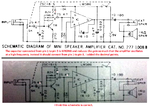cmh2001
Newbie level 5

- Joined
- Nov 8, 2014
- Messages
- 10
- Helped
- 0
- Reputation
- 0
- Reaction score
- 0
- Trophy points
- 1
- Location
- Oklahoma
- Activity points
- 73
My business uses the Radio Shack mono Mini-Amplifier, part 277-1008. This item is an integral part for a certain sensor that we use. Since Radio Shack may not be around forever, I need to find a replacement for this unit.
I'm considering making my own. Does anyone know of a similar circuit that would give me the same output? We feed the output into a car stereo audio auxillery input.
I'm considering making my own. Does anyone know of a similar circuit that would give me the same output? We feed the output into a car stereo audio auxillery input.



